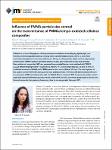Search
Author
- Altarugio, Julia P. (1)
- Carvalho, Antonio J. F. (1)
- Denthaje Krishna, Bhat (1)
- Muthu, Selvakumar (1)
- next >
Subject
Date issued
Has File(s)
- true (2)
Search Results
Presently, society needs an eco-friendlier alternative for non-biodegradable polymers, nonetheless, synthetic polymers have established the market because of cost and easy to manufacture. To address the challenge of reducing the lifetime of degradation of these polymers, the scope of blending natural biopolymers is effective. This paper focuses on confirming the effectiveness of biodegradation in the molecular level of polymer blends between synthetic polymers and biopolymers. The synthetic polymers such as poly (methyl methacrylate) (PMMA) and poly (vinyl chloride) (PVC) were blended with varying compositions of biodegradable cellulose acetate butyrate (CAB). |
Cellulose is a class of biopolymers that prominently contributes to developing lightweight, eco-friendly, and biodegradable plastics. Among them, nanofibrillated cellulose (NFC) is one of the most interesting due to its mechanical behavior. Mixing it with synthetic plastic such as poly(methyl methacrylate) (PMMA) reduces synthetic polymer usage, agro-industrial residue and develops fiber-reinforced composites. NFC was prepared from residual biomass and oxidized with TEMPO (2,2,6,6-tetramethylpiperidine-1-oxyl radical). Herein, NFC was incorporated (25, 50 and 75 wt%) in a colloidal emulsion of PMMA, with PMMA particle size control (50 and 175 nm). The investigation of this system on the PMMA/NFC transparency was addressed here. |


